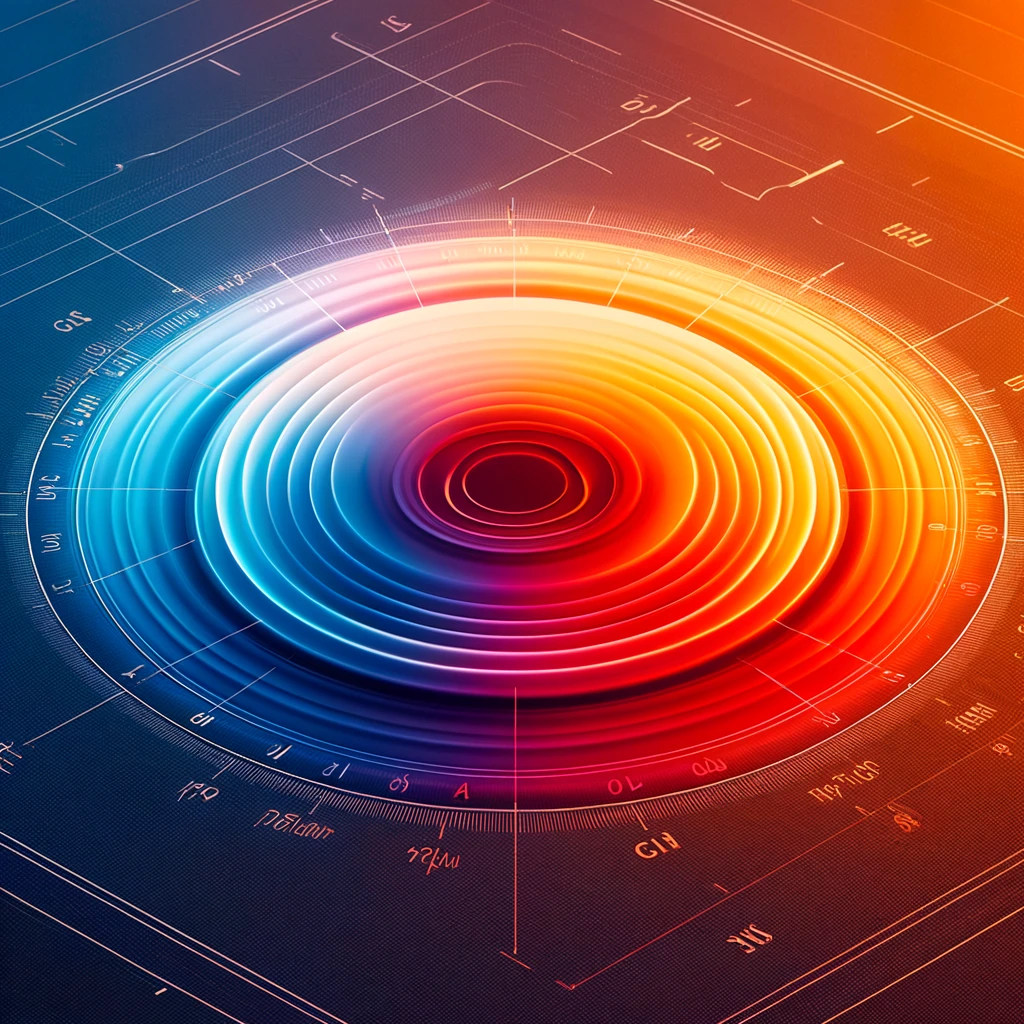Color Correlated Temperature: The Secret to Perfect Lighting
Imagine walking into a room and feeling instantly warmed by a cozy, amber glow, or being invigorated by the crisp, clear light reminiscent of a sunny afternoon. This magic is often the work of an unsung hero in the world of lighting design: Color Correlated Temperature (CCT).
CCT, measured in Kelvin, offers us a numerical glimpse into the character of light, guiding us from the warm embraces of a candlelit dinner to the energizing clarity of a daylight-filled studio.
It’s a concept rooted in the behavior of an ideal black-body radiator, transforming as it heats, from the deep reds of ember to the vivid blues of the midday sky.
Whether it’s the soft, inviting lights of a home or the functional brilliance of an office space, understanding CCT is your first step towards crafting the perfect ambiance with light.
Table of Contents
Prefer to watch instead of read? Click below.
Understanding Color Correlated Temperature (CCT) in Construction
Color Correlated Temperature, commonly abbreviated as CCT, is a fundamental term in the field of construction and interior design. It is a specification of the colour appearance of the light emitted by a lamp, relating its colour to the colour of light from a reference source when heated to a particular temperature, measured in degrees Kelvin (K). In simpler terms, it is a gauge of how warm or cool a light appears.
Breaking Down Color Correlated Temperature (CCT)
To better understand CCT, it is crucial to dissect the term.
The Concept of ‘Color’
In the realm of CCT, ‘colour’ does not refer to the entire spectrum of colours as we generally know it. Instead, it pertains to the shade of brightness that we perceive when a light source is turned on. It’s important to keep in mind that this ‘colour’ greatly impacts the ambiance of a space.
The Correlation with Temperature
The ‘temperature’ in CCT does not indicate the level of heat produced by a light source. Rather, it refers to the perceived warmth or coolness of a light source. In the CCT scale, lower values mean ‘warmer’ (reddish) light, while higher values mean ‘cooler’ (bluish) light.
The Significance of Correlation
As the phrase ‘correlated temperature’ suggests, CCT is a correlation rather than a direct measure. This correlation between the colour of light from a lamp and that from a reference source at a particular temperature gives us a more standardized, more comprehensible way of describing the colour characteristics of light.
Visualizing CCT
A common way to visualize CCT is to compare it to heating a theoretical ‘Black Body’ (like a piece of metal). As the temperature of this body increases, the colour changes from red, through yellow and white, to blue.
How is CCT Used in Construction?
In construction and design, the value of CCT helps in choosing the right lighting for a desired ambiance or mood in a room.
| CCT Value | Perception |
|---|---|
| 2700 – 3000K | Warm, cozy light |
| 3500 – 4100K | Neutral, bright light |
| 5000 – 6500K | Cool, daylight-like light |
Thus, for a more relaxed and warm atmosphere, a light with a lower CCT value (like 2700K) would be appropriate. For a workspace needing clear visibility, a light with a higher CCT value (like 5000K) may be more suitable.
In conclusion, understanding CCT can significantly impact the functionality and aesthetics of a built environment.

Digging Deeper into Correlated Color Temperature (CCT)
Correlated Color Temperature (CCT) isn’t only crucial for construction and design, but it also plays an integral role in photography, film production, and health and well-being. By diving deeper into CCT, we can unlock a fuller understanding of these versatile applications.
Unpacking CCT
Science Behind CCT
CCT is based on Planck’s law, which states that a black body radiator emits light at different colour temperatures depending on its heat temperature. In simple terms, the black body emits reddish light at lower temperatures but shifts towards bluish light as the temperature raises [source]. With the concept of CCT, this black body radiator is used as a reference source to which the colour of light from a lamp is compared.
Impact of CCT on Human Physiology
Beyond aesthetics and mood-setting, the value of CCT holds biological significance as well. The human body’s circadian rhythm, the internal process that regulates sleep-wake cycle, reacts differently to different CCTs. Increasing exposure to cooler light (higher CCT) during daytime can promote alertness and productivity while warm light (lower CCT) in the evening can help induce sleep, in line with circadian rhythm-based lighting design principles [source].
Applications of CCT Beyond Construction
CCT in Photography and Film Production
In the realm of photography and filmmaking, understanding and controlling CCT is vital for accurate colour reproduction. Photographers and cinematographers manipulate the colour temperature setting on their camera to match the CCT of their light source, enabling them to capture images or scenes with desired colour balance [source].
CCT in Health and Well-Being
The knowledge of CCT is also applied in healthcare facilities. For example, warm white light (low CCT) can create a calming environment in patient wards, while cool white light (high CCT) can enhance concentration and alertness in operation theatres [source]. Implementing the right CCT in a healthcare setting can therefore play a part in improving patient care and recovery.
| CCT Value | Applications |
|---|---|
| 2700 – 3000K | Residential interiors, patient wards |
| 3500 – 4100K | Commercial interiors, classrooms, office spaces |
| 5000 – 6500K | Visual tasks, operation theatres, daylight simulation |
To wrap it up, the versatile aspect of CCT extends beyond the construction and design industry. It encapsulates varied sectors like photography, film production, and healthcare, underscoring its broad impact and relevance.
Exploring Color Correlated Temperature (CCT) Further
Understanding CCT opens up the avenue for applications beyond aesthetics. By delving into how it correlates with physical responses, color perception in different environments, and its impact on different industries, we gain not just a deeper appreciation for CCT but also insights into its far-reaching implications.
Phenomenology of CCT
CCT and Physical Response
Our natural environments have influenced our physiological responses to color. Evolutionary patterns have ingrained in us a positive response to warm light, reminiscent of fire and safety, and a negative response to cooler shades, akin to moonlight or overcast skies suggestive of danger [source]. These innate responses to CCT carry over into our synthetic environments where lighting can make spaces feel inviting or somber.
Color Perception and CCT
Also, the context plays a significant role in perception. Depending on the surrounding colors, our eyes can interpret the same light as having a different CCT. This evidence of color constancy emphasizes the connection between CCT and color perception [source].
Wider Implications of CCT
CCT in Retail and Advertising
In retail and advertising, knowledge of CCT is used strategically to influence consumer behavior. Different CCTs can highlight different product features or create a specific atmosphere that attracts potential buyers [source].
CCT in Digital Spaces
In the digital world, understanding CCT is also essential for designing user interfaces and user experiences. For example, giving users an option to switch between a light (higher CCT) and dark (lower CCT) mode can enhance readability and comfort [source].
CCT in Aerospace
Even outer space isn’t a CCT-free zone. Astronauts’ health on long missions can receive a significant boost through the strategic use of CCT in spacecraft habitats to mitigate the effects of cosmic isolation and maintain circadian rhythms [source].
| CCT Value | Implications |
|---|---|
| 2700 – 3000K | Enhancing comfort, safety, and intimacy |
| 3500 – 4100K | Good for reading, workspaces, retail applications |
| 5000 – 6500K | Enhancing alertness, daylight simulations, astronaut habitats |
In conclusion, the knowledge of CCT extends far beyond our living spaces and professional desks; it impacts various realms from retail, digital experiences, and even outer space. With the advancement of technology, understanding CCT’s versatile applications gives us an essential tool for shaping not just our physical environments but also the digital and outer space habitats we interact with.

Defining CCT Values And Common Applications
Interpreting CCT Values
The CCT value denotes whether a light emits a warm (lower Kelvins, such as 2000K-3000K) or cool (higher Kelvins, 5000K or more) kind of white light. Remember, CCT has nothing to do with the physical heat or the energy-efficiency of the lamp.
- Less than 2000K: Gives off a dim glow, similar to candlelight.
- 2000K-3000K: Provides a soft, warm white light.
- 3100K-4500K: Emits a cool, bright white light.
- 4600K-6500K: Delivers a super cool, bright light that’s similar to daylight.
- Above 6500K: Mimics natural daylight. Such bulbs are employed in specialty applications.
How is CCT Relevant?
CCT plays a significant role in selecting the right light for a specific space. A cool white light can be suitable for commercial or task-related situations, like office buildings or kitchens, where a clear and bright light is required. Meanwhile, warm white lights can enhance ambiance and comfort, making them suitable for living rooms, restaurants, or hotels.
CCT and Light Quality
It’s essential to understand that while CCT can define the warmth or coolness of light, it doesn’t measure light quality. So two lamps with the same CCT can produce the light of very different qualities.
Choosing the right CCT for your space
If you’re not quite sure which CCT you’ll need for your space, consider consulting with a lighting designer who can advise about the perfect lighting solution tailored to your needs.
Remember, at the end of the day, the best CCT is really dependent on individual taste, the type of task to be performed, and the atmosphere you want to create in the space.
Shining A Final Light On Color Correlated Temperature
CCT is a valuable scale that helps us understand and select the right light source according to our specific needs and preferences. By utilizing the CCT scale, we can customize our environments to enhance productivity, comfort and overall ambience.
If you’re keen to delve into further lighting terminology, check out the Illuminating Engineering Society guidelines where you can find comprehensive information and standards.
In conclusion, Color Correlated Temperature (CCT) plays a pivotal role in the realm of construction and design, extending far beyond the basic understanding of light. It provides a nuanced perspective on the impact of ‘color’ and ‘temperature,’ allowing us to shape and influence the ambiance of a space. As we’ve found, this terminology does not conform to the typical way we interpret these words. CCT allows us to use light not just as a functional tool for visibility, but as an influential element in creating desired moods and atmospheres.
From our perspective, understanding the concept of CCT is a vital aspect in creating spaces that resonate with their intended purpose, be it a cosy living room or a brightly-lit workspace. The usefulness of this nuanced knowledge can help us make more informed choices while designing or altering our built environments.






